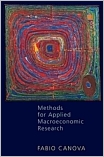| |||||
• polskie
• Zamów informacje o nowościach z wybranego tematu • kontakt |
METHODS FOR APPLIED MACROECONOMIC RESEARCHCANOVA F.wydawnictwo: PRINCETON, 2007, wydanie Icena netto: The last twenty years have witnessed tremendous advances in the mathematical, statistical, and computational tools available to applied macroeconomists. This rapidly evolving field has redefined how researchers test models and validate theories. Yet until now there has been no textbook that unites the latest methods and bridges the divide between theoretical and applied work. Fabio Canova brings together dynamic equilibrium theory, data analysis, and advanced econometric and computational methods to provide the first comprehensive set of techniques for use by academic economists as well as professional macroeconomists in banking and finance, industry, and government. This graduate-level textbook is for readers knowledgeable in modern macroeconomic theory, econometrics, and computational programming using RATS, MATLAB, or Gauss. Inevitably a modern treatment of such a complex topic requires a quantitative perspective, a solid dynamic theory background, and the development of empirical and numerical methods - which is where Canova's book differs from typical graduate textbooks in macroeconomics and econometrics. Rather than list a series of estimators and their properties, Canova starts from a class of DSGE models, finds an approximate linear representation for the decision rules, and describes methods needed to estimate their parameters, examining their fit to the data. The book is complete with numerous examples and exercises. Today's economic analysts need a strong foundation in both theory and application. Methods for Applied Macroeconomic Research offers the essential tools for the next generation of macroeconomists. Fabio Canova is ICREA Research Professor at the University of Pompeu Fabra in Barcelona and Fellow of the Centre for Economic Policy Research in London. Table of Contents Preface Chapter 1: Preliminaries Chapter 2: DSGE Models, Solutions, and Approximations Chapter 3: Extracting and Measuring Cyclical Information Chapter 4: VAR Models Chapter 5: GMM and Simulation Estimators Chapter 6: Likelihood Methods Chapter 7: Calibration Chapter 8: Dynamic Macro Panels Chapter 9: Introduction to Bayesian Methods Chapter 10: Bayesian VARs Chapter 11: Bayesian Time Series and DSGE Models Appendix A Statistical Distributions References Hardcover, 492 pages Księgarnia nie działa. Nie odpowiadamy na pytania i nie realizujemy zamówien. Do odwolania !. |


